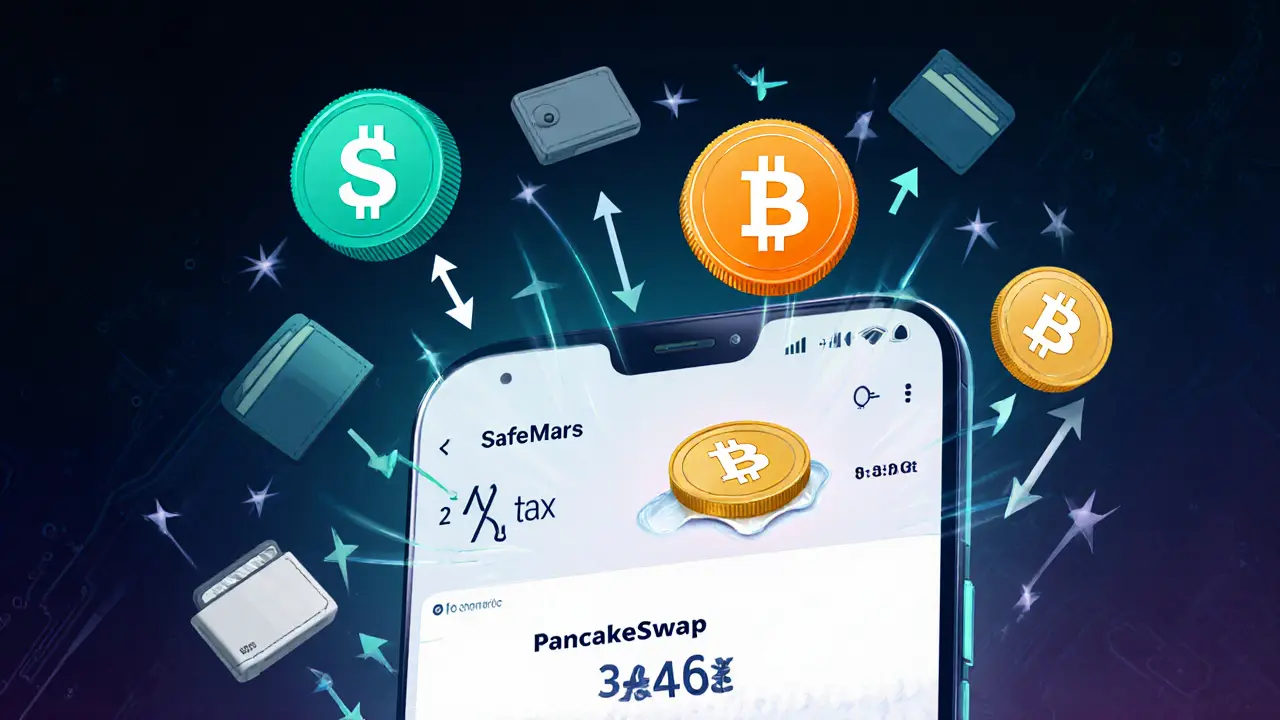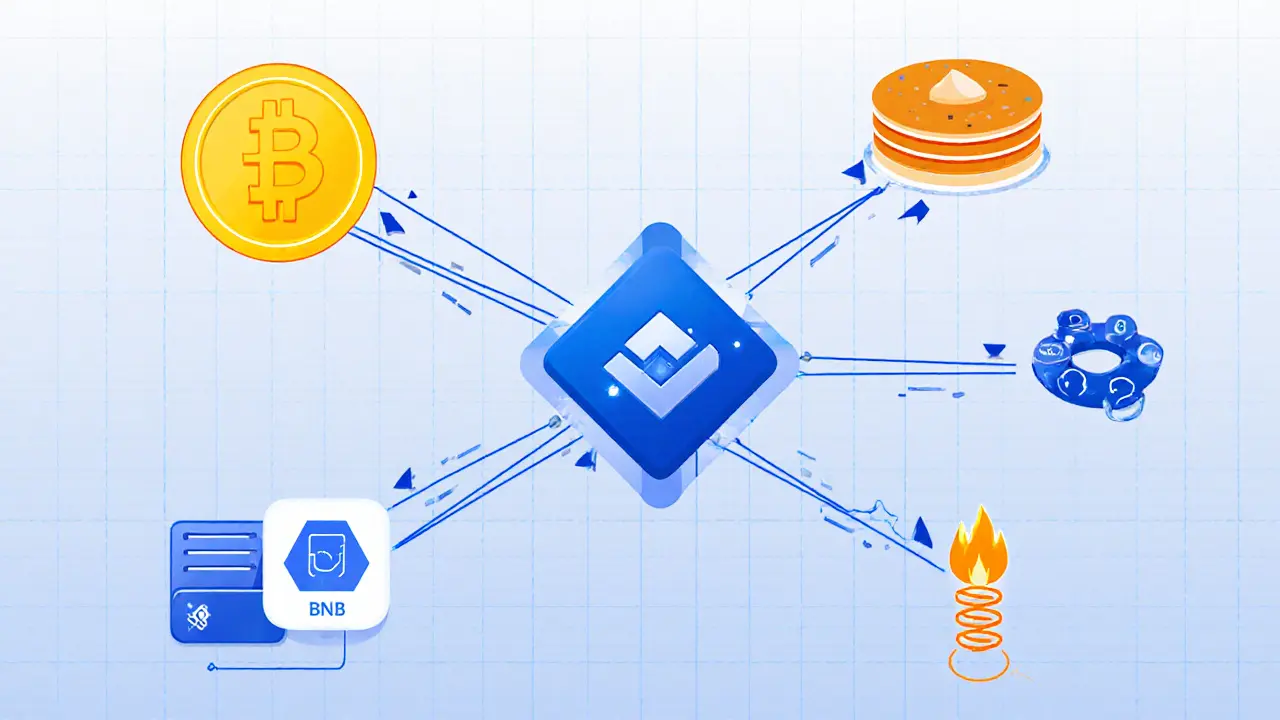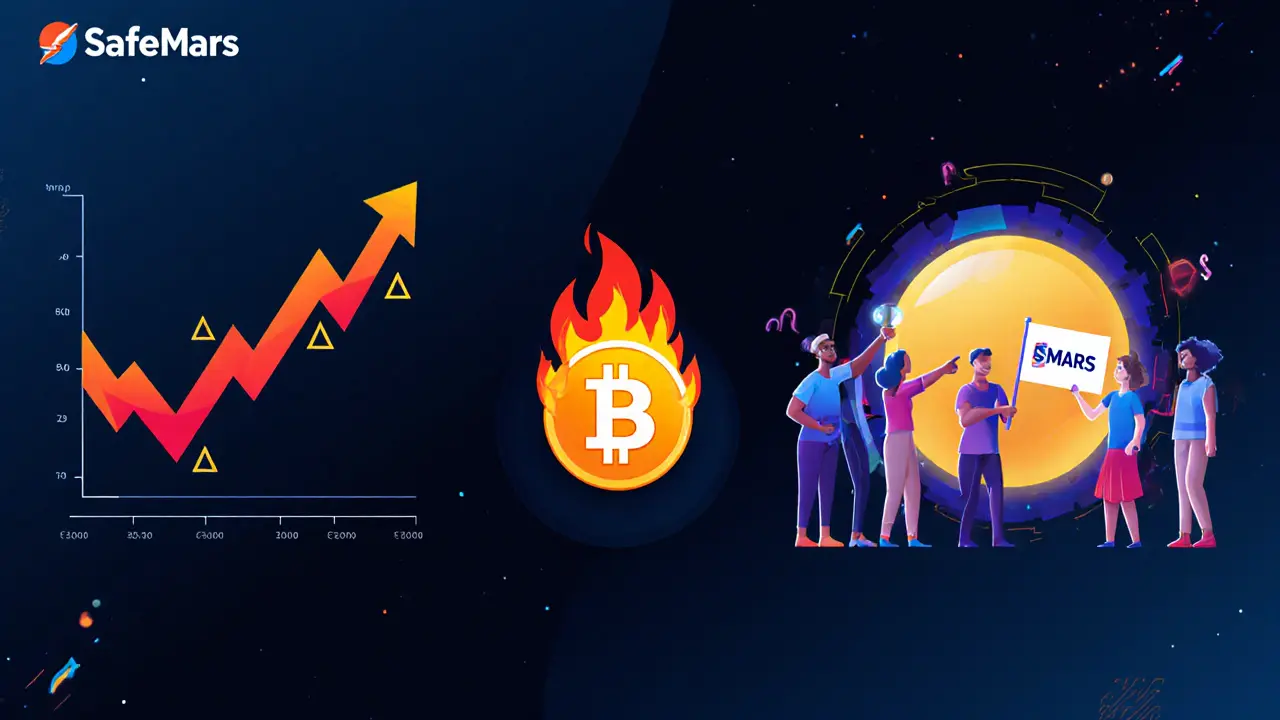Oct 8, 2025, Posted by: Ronan Caverly

SafeMars (SMARS) Tax Calculator
Transaction Tax Breakdown
SafeMars charges a 4% transaction tax on every buy/sell. This tax is split evenly between reflections, liquidity, and burning.
Tax Distribution Results
About SafeMars (SMARS)
SafeMars is a deflationary cryptocurrency built on Binance Smart Chain. It distributes a portion of every transaction back to holders and adds liquidity automatically.
Imagine earning crypto just by holding a token in your wallet, no farming, no staking, and no constant trading. That’s the promise behind SafeMars, a micro‑cap DeFi token that relies on automatic reflections and liquidity generation to reward its community.
SafeMars (SMARS) is a deflationary cryptocurrency built on the Binance Smart Chain (BSC) that distributes a portion of every transaction back to holders and adds liquidity automatically. Launched as a fair‑launch, community‑driven project, SafeMars employs a 4% transaction tax split evenly between reflections and liquidity pool funding.
How the 4% Transaction Tax Works
- 2% Reflection: Every time SMARS is bought or sold, half of the tax is instantly and gaslessly sent to all existing wallets. Holders see their balances grow without any manual claim.
- 2% Liquidity: The other half is paired with BNB (Binance Coin) and added to the Liquidity Pool on PancakeSwap. This continuously raises the price floor and improves market depth.
- Burn Mechanism: A small portion of each transaction is also burned, slowly reducing total supply and creating scarcity over time.
Key Components of the SafeMars Ecosystem
Understanding the surrounding infrastructure helps you gauge the token’s long‑term viability.
- Binance Smart Chain (BSC): The low‑fee, high‑throughput blockchain that powers SMARS transactions.
- BNB: The native BSC coin used to pay gas fees and to pair with SMARS for liquidity.
- PancakeSwap: The primary decentralized exchange where SMARS trades, mainly in the SMARS/WBNB pair.
- Reflection Token Model: A tokenomics style, popularized by projects like SafeMoon, where automatic rewards replace traditional farming.
- DeFi Token Classification: SMARS falls under the broader DeFi token umbrella, meaning it operates without a central authority.
Market Performance Snapshot (September2025)
As of 18September2025, SMARS is priced around $0.00000000619, with a 24‑hour volume of roughly $52,300 and a market‑cap ranking near 4,527. The token has shown a 10.9% price rise in the last day and a 70.43% gain over the past year, indicating high volatility typical of micro‑cap assets.

Historical Price Peaks & Valleys
- All‑time high: 0.28888e‑5USDT on 11May2021.
- Lowest point: 0.22e‑8USDT on 12May2022.
- Early‑2024 dip: Dropped below $0.00000000312 for the first time since 2021.
What Analysts Are Saying
Predictions vary, but most bullish forecasts target a breach of $0.0000000114 by the end of 2025, with some conservative models placing SMARS between $0.0000000056 and $0.0000000069. Longer‑term models suggest a potential rise to $0.0000000380 by 2030, contingent on community growth and broader BSC adoption.
Comparison with Similar Reflection Tokens
| Feature | SafeMars (SMARS) | SafeMoon | Reflecto |
|---|---|---|---|
| Blockchain | Binance Smart Chain | Binance Smart Chain | Ethereum (ERC‑20) |
| Transaction Tax | 4% (2% reflection, 2% liquidity) | 10% (5% reflection, 5% liquidity) | 5% (2% reflection, 3% liquidity) |
| Liquidity Pair | SMARS/WBNB on PancakeSwap | SafeMoon/WBNB on PancakeSwap | Reflecto/ETH on Uniswap |
| Current Price (Sept2025) | $0.00000000619 | $0.0000000152 | $0.0000000028 |
| Market Cap Rank | ~4,527 | ~2,300 | ~12,000 |

How to Buy & Store SafeMars Safely
- Set up a BSC‑compatible wallet (MetaMask, Trust Wallet, or Binance Chain Wallet).
- Fund the wallet with BNB to cover gas fees.
- Visit PancakeSwap, select the SMARS/WBNB pair, and adjust slippage tolerance (typically 5‑7%).
- Confirm the swap, then verify the SMARS balance appears in your wallet.
- Enable “auto‑receive reflections” - no extra steps needed; the protocol handles it.
Tip: Because SMARS trades at ultra‑low prices, use the “custom token address” feature to avoid selection errors.
Risks & Red Flags to Watch
- Extreme Volatility: Prices can swing 100%+ in a day; small trades may be wiped out by gas costs.
- Liquidity Constraints: Most volume flows through a single pair; large sell orders can cause steep price impact.
- Regulatory Uncertainty: Automatic reflections may be deemed securities‑like in certain jurisdictions.
- Limited Utility: Apart from passive rewards, SMARS offers little functional use case.
- Community‑Driven Governance: No formal roadmap means future development depends on volunteer contributors.
Future Outlook & Development Possibilities
For SMARS to survive beyond speculation, the community would need to add real‑world utility-perhaps integrating with NFT marketplaces or staking platforms. Ongoing maintenance of the smart contract, periodic audits, and clear communication can also boost investor confidence.
Frequently Asked Questions
What is SafeMars (SMARS) and how does it differ from SafeMoon?
SafeMars is a deflationary token on Binance Smart Chain that uses a 4% tax (2% reflection, 2% liquidity). SafeMoon applies a higher 10% tax and operates with a larger community. Both reward holders automatically, but SafeMars has a lower fee structure and a smaller market footprint.
Do I need to claim SMARS reflections?
No. Reflections are distributed instantly on each transaction, directly to every wallet that holds SMARS. You just keep the token in your address.
What wallets are compatible with SafeMars?
Any wallet that supports Binance Smart Chain works - MetaMask (configured for BSC), Trust Wallet, Binance Chain Wallet, and Ledger hardware wallets are the most common choices.
Is SafeMars a good long‑term investment?
It’s high risk. The token’s growth depends on community activity, liquidity, and possible regulatory actions. Consider it speculative and allocate only money you can afford to lose.
How can I reduce the impact of BNB gas fees when trading SMARS?
Trade during low‑traffic periods, bundle multiple transactions, or use a wallet that lets you set a custom gas price. Keep enough BNB in your wallet to cover fees before swapping.
Write a comment
Comments
Franceska Willis
Yo, SafeMars looks like another tax‑rich meme coin.
October 8, 2025 AT 09:07
EDWARD SAKTI PUTRA
I can see why people get drawn to the idea of auto‑reflections, but it’s worth remembering that a 4% tax on every trade can really eat into your gains over time. It’s a balancing act between those rewards and the hidden cost you pay each time you move the token.
October 10, 2025 AT 15:40
Bryan Alexander
Wow, the way SMARS promises instant reflections feels like a fireworks show for your portfolio! If you hold steady, those tiny 2% bursts could pile up into something spectacular, but the drama of a 4% tax could also sting if you’re not careful.
October 12, 2025 AT 23:13
Patrick Gullion
Honestly, another token with a tax sounds like the same old song. Sure, they say it funds liquidity and burns supply, but you end up paying just to be part of the party. It’s a classic hustle.
October 15, 2025 AT 06:46
Jack Stiles
Looks pretty straightforward: buy, get a slice of the tax back, and hope the price goes up. Just keep an eye on the tax‑drag, especially if you trade a lot.
October 17, 2025 AT 14:20
Ritu Srivastava
It’s irresponsible for projects to market themselves as “safe” while hiding massive transaction fees. Investors deserve transparency, not clever marketing fluff.
October 19, 2025 AT 21:53
Liam Wells
From a purely analytical perspective, the deflationary mechanism-burning a portion of each transaction-does theoretically reduce supply; however, the efficacy of such a model is contingent upon sustained demand, which, in the current market environment, remains highly speculative and unproven. Moreover, the 4% tax imposes a non‑trivial barrier to liquidity, potentially discouraging larger investors from engaging with the token.
October 22, 2025 AT 05:26
Nicholas Kulick
SafeMars’s tokenomics are built around a 4% transaction tax, split evenly between reflections, liquidity provisioning, and token burning. The reflection portion immediately redistributes 2% of each trade to existing holders, which can create a modest passive income stream if you maintain a sizeable position. The liquidity allocation-another 2%-is added to the pool on Binance Smart Chain, theoretically stabilizing price fluctuations and reducing slippage for future trades. The burning mechanism permanently removes the remaining 2% from circulation, aiming to create a deflationary pressure that could increase scarcity over time.
From a risk‑management standpoint, the constant tax can erode profit margins, especially for active traders who execute multiple buys and sells. Short‑term arbitrage opportunities are limited because every transaction incurs the same fee, reducing the net spread. Additionally, the automatic liquidity addition means that the pool’s composition can shift unpredictably, potentially leading to imbalanced token ratios.
Investors should also consider the contract’s code audit status. A transparent, publicly‑available audit reduces the likelihood of hidden backdoors or minting functions that could undermine the token’s deflationary promise. Community governance, if any, plays a role in how future tax adjustments or token burns are decided, impacting long‑term sustainability.
In summary, while the tokenomics present an appealing blend of rewards and scarcity, the 4% tax is a double‑edged sword that can both incentivize holding and penalize trading. Potential holders need to weigh the passive income from reflections against the cumulative tax drag, especially in volatile market conditions.
October 24, 2025 AT 13:00
Caleb Shepherd
Everyone forgets that these “deflationary” coins are often just a front for a pump‑and‑dump scheme. The tax is a clever way to funnel money into the developers' wallets while making it look like a community‑driven project.
October 26, 2025 AT 20:33
Darren Belisle
Interesting point, Caleb-while the tax does look like a revenue stream for the team, it also forces a sort of “skin in the game” for holders. If the community truly believes in the vision, the reflections could offset some of that drag over the long term!!
October 29, 2025 AT 04:06
Heather Zappella
From a cultural perspective, it’s fascinating how many projects borrow the “Mars” motif to convey ambition, yet the underlying mechanics often remain unchanged. Investors should focus on the code rather than the branding.
October 31, 2025 AT 11:40
Jason Wuchenich
Just a heads‑up: if you’re planning to hold SMARS for the long haul, make sure you’re comfortable with the ongoing 4% tax. It’s a commitment, but the auto‑liquidity could help keep the market stable.
November 2, 2025 AT 19:13
Kate O'Brien
Look, the tax feels like a hidden fee that the devs use to fund their own wallets. And that’s exactly why I’m skeptical- it’s the classic “everyone gets a piece” trick.
November 5, 2025 AT 02:46
Ricky Xibey
SMARS seems cool, but that 4% tax will bite you if you flip too often.
November 7, 2025 AT 10:20
Sal Sam
From a technical lens, the tax‑allocation algorithm operates on a proportional basis; each transaction triggers a smart‑contract function that calculates 2% for reflections, 2% for liquidity, and the remainder for burning. This ensures deterministic behavior but also embeds a fixed friction cost in every trade.
November 9, 2025 AT 17:53
Moses Yeo
One must consider-if the developers retain back‑door privileges, the entire architecture could be subverted at any moment; thus, the presence of a tax does not inherently guarantee community benefit; rather, it may simply be a veil for centralized control!!!
November 12, 2025 AT 01:26
Lara Decker
While the tax is plainly declared, the real risk lies in the opaque distribution of the liquidity portion-if the pool becomes imbalanced, price manipulation becomes trivial.
November 14, 2025 AT 09:00
Anna Engel
Oh great, another “safe” coin that’s basically a tax‑collector disguised as a community project. How original.
November 16, 2025 AT 16:33
manika nathaemploy
i think its kinda cool but u should read the fine print firstr!
November 19, 2025 AT 00:06
Marcus Henderson
In conclusion, the SMARS token presents a balanced blend of reflection incentives and deflationary mechanics. Should the community uphold transparency and continue diligent audits, the project could evolve into a sustainable fixture within the BSC ecosystem.

Author
Ronan Caverly
I'm a blockchain analyst and market strategist bridging crypto and equities. I research protocols, decode tokenomics, and track exchange flows to spot risk and opportunity. I invest privately and advise fintech teams on go-to-market and compliance-aware growth. I also publish weekly insights to help retail and funds navigate digital asset cycles.